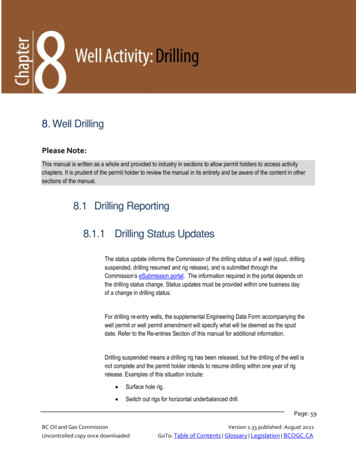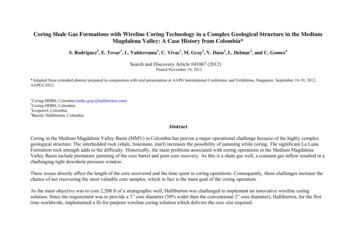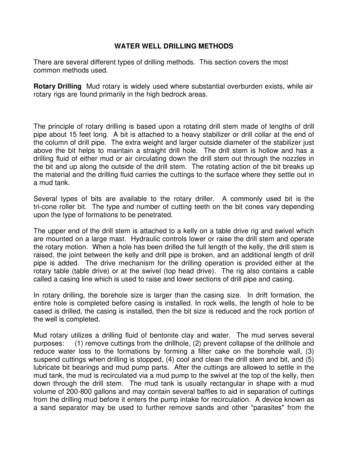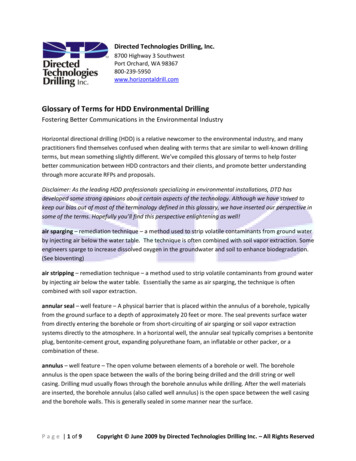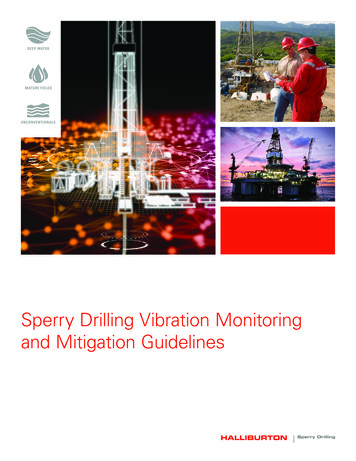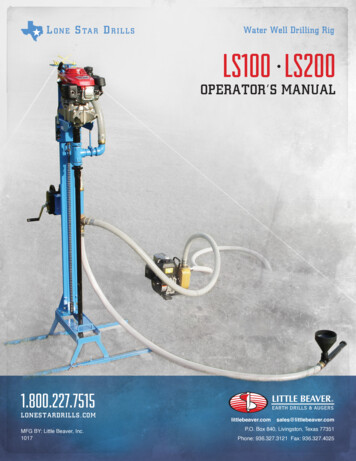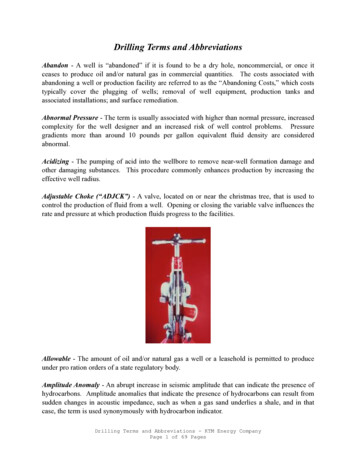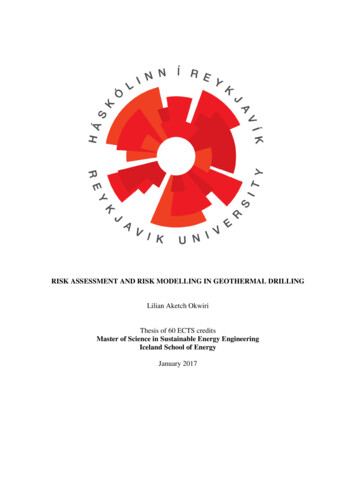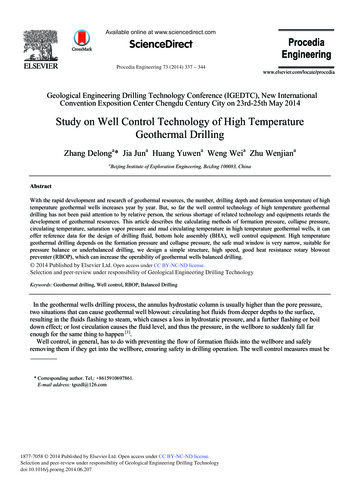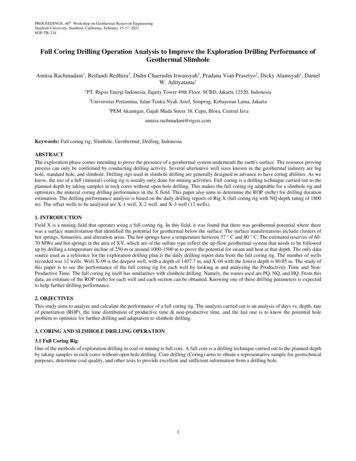
Transcription
PROCEEDINGS, 46th Workshop on Geothermal Reservoir EngineeringStanford University, Stanford, California, February 15-17, 2021SGP-TR-218Full Coring Drilling Operation Analysis to Improve the Exploration Drilling Performance ofGeothermal SlimholeAnnisa Rachmadani1, Reifandi Redhiza2, Didin Chaerudin Irwansyah3, Pradana Vian Prasetyo2, Dicky Alamsyah1, DanielW. Adityatama11PT.Rigsis Energi Indonesia, Equity Tower 49th Floor, SCBD, Jakarta 12520, Indonesia2UniversitasPertamina, Jalan Teuku Nyak Arief, Simprug, Kebayoran Lama, Jakarta3PEMAkamigas, Gajah Mada Street 38, Cepu, Blora, Central Javaannisa.rachmadani@rigsis.comKeywords: Full coring rig, Slimhole, Geothermal, Drilling, IndonesiaABSTRACTThe exploration phase comes intending to prove the presence of a geothermal system underneath the earth's surface. The resource provingprocess can only be confirmed by conducting drilling activity. Several alternative well sizes known in the geothermal industry are bighole, standard hole, and slimhole. Drilling rigs used in slimhole drilling are generally designed in advance to have coring abilities. As weknow, the use of a full (mineral) coring rig is usually only done for mining activities. Full coring is a drilling technique carried out to theplanned depth by taking samples in rock cores without open hole drilling. This makes the full coring rig adaptable for a slimhole rig andoptimizes the mineral coring drilling performance in the X field. This paper also aims to determine the ROP (m/hr) for drilling durationestimation. The drilling performance analysis is based on the daily drilling reports of Rig X (full coring rig with NQ depth rating of 1800m). The offset wells to be analyzed are X-1 well, X-2 well, and X-3 well (12 wells).1. INTRODUCTIONField X is a mining field that operates using a full coring rig. In this field, it was found that there was geothermal potential where therewas a surface manifestation that identified the potential for geothermal below the surface. The surface manifestations include clusters ofhot springs, fumaroles, and alteration areas. The hot springs have a temperature between 37 C and 80 C. The estimated reserves of 6070 MWe and hot springs in the area of XY, which are of the sulfate type reflect the up-flow geothermal system that needs to be followedup by drilling a temperature incline of 250 m or around 1000-1500 m to prove the potential for steam and heat at that depth. The only datasource used as a reference for the exploration drilling plan is the daily drilling report data from the full coring rig. The number of wellsrecorded was 12 wells. Well X-09 is the deepest well, with a depth of 1407.7 m, and X-04 with the lowest depth is 80.85 m. The study ofthis paper is to see the performance of the full coring rig for each well by looking at and analyzing the Productivity Time and NonProductive Time. The full coring rig itself has similarities with slimhole drilling. Namely, the routes used are PQ, NQ, and HQ. From thisdata, an estimate of the ROP (m/h) for each well and each section can be obtained. Knowing one of these drilling parameters is expectedto help further drilling performance.2. OBJECTIVESThis study aims to analyze and calculate the performance of a full coring rig. The analysis carried out is an analysis of days vs. depth, rateof penetration (ROP), the time distribution of productive time & non-productive time, and the last one is to know the potential holeproblem to optimize for further drilling and adaptation to slimhole drilling.3. CORING AND SLIMHOLE DRILLING OPERATION3.1 Full Coring RigOne of the methods of exploration drilling in coal or mining is full core. A full core is a drilling technique carried out to the planned depthby taking samples in rock cores without open hole drilling. Core drilling (Coring) aims to obtain a representative sample for geotechnicalpurposes, determine coal quality, and other tests to provide excellent and sufficient information from a drilling hole.1
Rachmadani et al.Figure 1. Core sample extracted by full core drilling operation during coal exploration in Kuala KuayanThe rock core sample is shaped like a tube, and the size will be following the drilling pipe used. Sampling is usually per 1.5 m or 3 m,depending on the length of the pipe used.3.2 Slimhole Drilling3.2.1 DefinitionThere is no formal standard that classifies wells (especially geothermal well) based on their diameter. Society of Petroleum Engineers(SPE) defines a slim hole well as a well with a casing size less than 7” for 90% of its depth, while ISOR defines a slim hole well as a wellwith a final diameter less than 6” (Thorhallsson, 2016). However, the most commonly used definition is that any well with a wellborediameter less than 6” is considered a slimhole well (Schlumberger, 2020; Mackenzie et al., 2017). Apart from wellbore diameter, in thegeothermal industry worldwide, there are three types of well commonly used for exploration based on their objectives and depth: 1)temperature gradient well, 2) deep slimhole well, 3) conventional/standard/big well (Mackenzie et al., 2017). Table 1 summarizes thetypical depth and objectives for the well configuration commonly used for geothermal exploration.Table 1. Typical well configuration used for geothermal exploration (modified from Mackenzie et al., 2017).Type of WellTemperature gradientDeep slimhole(Prod. Casing 2-3/4” – 7”)Conventional/Standard/Big hole(Prod. Casing 9-5/8” – 13-3/8”)Typical DepthObjective(s)200 – 800 m vertical depthTypically drilled above the reservoir 500 – 2,000 m vertical depthTypically drilled through clay capand reach the reservoir 1,500 – 3,000 m vertical depth Confirm the presence of clay cap Confirm temperature Validate the conceptual model. Confirm adequate temperature forcommercial production (primaryobjective) Test productivity (secondary objective). Provide comprehensive testing of resourceproductivity It might be used for production orinjection.Thermal gradient well generally implemented not for exploration but to confirm the presence of clay cap and the temperature. SlimholeWell applied for drilling operation to reach the reservoir target. This well type is utilized to confirm the reservoir's temperature, commercialproduction, and productivity test. Whereas the Conventional or Big Hole Well is implemented to reach the subsurface data and iscommonly used for production or injectivity requirements.Apart from the related necessity and applications, there are also differences in casing design or well configuration between Deep SlimholeWell, Standard Hole Well, and Big Hole Well. This is clearly shown in figure 2.2
Rachmadani et al.Figure 2. Typical well configuration for big, standard, and slim holes (Purba et al., 2019).3.3 PT NPT Explanation3.3.1 PT (Productive Time)Productivity can be defined as a multiplier of effectiveness and efficiency if both of their value increase will also increase the sumproductivity. Besides, the efficiency of a process is a measure of the resource consumed to run the process. Meanwhile, effectiveness isdefined as a scenario where actual throughput is at least equal to but ideally larger than expected throughput.Increasing the asset's productivity during its “productive time” can reduce the non-productive time as well. An asset with higherproductivity will cost less to operate, resulting in shorter drilling campaigns and increasing the ROP.3.3.2 NPT (Non-Productive Time)Non-productive time (NPT) is an unexpected event outside of the original plan of a drilling project. Hence, it does not have any standardsor clauses in its measurement. Rabia (2001) defines NPT as the time taken for any routine or abnormal operation that is carried out due toa failure or an event that causes the drilling operation to stop. The most frequently recorded NPTs in the field during a drilling operationare reaming, stuck pipe, loss, and equipment problems. The repetitive occurrence of an event usually marks NPT due to a specific cause,and hence in most cases, it could consume a long time and duration.These definitions of NPT suit the objective in which they are used. According to Rabia’s (2001), NPT is useful as a performance indexand a measure of how well the time is utilized in useful activities. As an illustration, the highest expense in a drilling operation is the dailyrig rates. If the operation happened to stop due to problems, the daily rig rates would still run as usual. This is a time when the operationis referred to be non-productive4. CASE STUDYThe data used to do the analysis is the Daily Drilling Reports (DDR) of X1 – X12 Well that was drilled by using “Y” Full Coring Rig.The X1 – X12 wells are sorted based on the well's name, not the time when it was drilled. In some cases, the wells only have partial DDRdata. The X1 Well only has DDR of its HQ section and X4 & X12 Well only has the PQ section. Nevertheless, this partial data is includedin the calculation to support the heterogeneity of the data to be analyzed.Table 2. General Well Information Drilled by "Y" Full Coring 9832.4640.814.003PQ sec.DurationHQ sec.DurationNQ 436.4016.7318.98-days10.3212.8718.29-
Rachmadani et al.Figure 3. Drilling Depth vs Duration Record with “Y” Full Coring Rig4.1 DvDOne of the results of the drilling analysis process is the Days vs Depth chart. In this analysis using 12 (twelve) offset wells in Field X,data of completion time and well depth from all wells will be plotted in the form of the Duration (days) vs Depth (mMD) graph as shownin Figure 4. The graph shows the total completion time for each well in Field X by considering the NPT that occurs during operation. Thisgraph also shows that the occurrence of NPT mostly begins to appear at depths below 200 mMD.Figure 4. Day vs Depth with NPT in Field X4
Rachmadani et al.Well X-05 owns the deepest well depth. However, the most prolonged drilling duration is owned by well X-02. This is due to many NPTactivities with a long duration that occurred when drilling the X-02 well. At well X-02, there were several times stuck, with remedialaction reaming, but like at a depth of about 500m reaming could not solve the stuck problem. So, Re-drill activities are taken to overcomethis.Even though in Figure 4, all wells do not have the same well depth, through comparison of duration between "with NPT" and "withoutNPT", it can be seen that the deeper the hole, the wider the variation that occurs. This can be considered an early indication that in FieldX (offset wells), the difficulty of drilling increases as the well is deeper.4.2 PT NPTFigure 5 shows the result of Productive Time (PT) and Non-Productive Time (NPT) distribution of the drilling operation of 12 wells in XField. Based on the results, drilling operations were successful, with a productive time percentage reached 63%. However, the percentageof non-productive time was still high at 37%.Figure 5. PT NPT Distribution4.3 NPT BreakdownHere is the Non-Productive Time (NPT) Breakdown from the results of 12 wells that had been drilling in X Field. Based on the PT andNPT Distribution, Non-Productive Time taken 37% of drilling time or 6145.25 hours. There was 12 drilling hazard that happened in XField. Figure 6 explains the details of the proportion of drilling problem occurred in X Field.Figure 6. NPT Breakdown of the 12 total wellsFor this project, there were five drilling problems out of the total that had the most influence. The first is the WAIT code, which meansthe waiting process in this drilling project, where it took 1823.5 hours or 30% of the total NPT time. The second is REAM Code, whichmeans reaming process. These problems took time 16% of the total NPT time or 1017.5 hours.The third problem is STUC code, which means stuck condition when drilling operations. This problem had 807 hours or 13% of totalNPT time, and the fourth is FISHING. This code means fishing in drilling was on this project, took 12% of total NPT time or 713 hours.Moreover, the last is RMOV Code or Rig Move. This problem has happened before drilling activity in general. This problem took time9% portion of total NPT time or 534.5 hours duration.5
Rachmadani et al.Table 3. TOP 5 NPT based on NPT duration in 12 wellsNPTDuration (hr)Percentage (Compared to NPT 312%RMOV534.59%4.4 ROP and Completion Time RateROP (Rate of Penetration) is the time needed to drill one meter length of formation in a well section. Thus, ROP can be expressed as thetotal length of a section divided by the time to drill/coring (adding the section depth) the section of the well. Any operations that did notadd depth, such as taking a survey, cementing, and solving some drilling problems of the well, will not be included in the ROP calculation.Figure 7. ROP Summary of All Wells without NPTFigure 8. ROP Summary of All Wells with NPTWhile CTR (Completion Time Rate) is the rate of time needed to finish/complete a section of the well. The CTR formula is the totallength of a section divided by the time to finish a section. All operations to finish the section will be included in the calculation, whetheradding the depth.6
Rachmadani et al.Figure 9. Section Completion Rate Summary of All Wells without NPTFigure 10. Section Completion Rate Summary of All Wells with NPT4.5 Prevention & Mitigation Plan of Potential Drilling Problema. WaitMore efficient working time scheduling to finish some jobs that can be done at the same time in the same time, thus preventthe waiting time of another job to be done first.b. ReamConsider applying other methods to handle pipe stuck. These methods include jarring action or pumping particular chemicalsto free the pipe.c. Stuck Optimize viscosity, PV, and YP of mud to maximize cutting lifting Hole cleaning circulation before tripping out the string Circulate mud 5-10 minutes before adding the new string to clean out cutting around BHA Observe the drilling parameter and change of trend routinely Optimize ROP and hole cleaningd. FishingEducate the drilling crew to be aware of the equipment that easily dropped into the wellbore. If the fishing operation is causedby the drill string stuck, consider preventing every operation that will exceed the drill string make up torque or maximumtorque that can be applied to drilling.e. Rig MovingAdd some transporters (truck or copper) to cut the moving rig time from one point to another.7
Rachmadani et al.4.6 Slim Hole Drilling Time Estimates Based on ROPBased on the average ROP (Rate of Penetration) of X1 – X12 Wells and located in the same field (same formation), the proposed slimhole drilling time can be estimated. All data about the proposed slim hole well schematic is based on the actual proposed well. Therequired slim hole drilling operations time that is not attended during full coring drilling operation, such as BOP installation, will beassumed as long as the average operation time in the drilling operation of geothermal wells in a field in the same country proposed slimhole drilling. According to the proposed slim hole schematic and table “ROP Summary”, below is the Slim Hole Drilling TimeEstimates"X" SLIMHOLE ESTIMATED DRILLING TIME010203040Duration, Day50607080901000Drilling 8-1/2" hole, Cementing7" Casing, and Nipple up BOPDepth, m500Drilling 6-1/2" Hole, Cementing 41/2" Casing, and Nipple BOP and1000Coring 3-3/4" hole, set 3-1/2"Coring 2.98" hole and set2-7/8" liner15002000Without NPTWith NPTFigure 11. X Slimhole Estimated Drilling Time5. CONCLUSIONThis study involves 12 mining well drilling operations to be analyzed and results in several beneficial analyses to improve Slimhole Xgeothermal exploration drilling operation. Based on the analysis, the operation of PT (productive time) is 26% higher than the NPT (NonProductive Time) operation. Although the PT is higher than NPT, the PT should be optimized to be as high as possible for Slimhole Xdrilling operation. The most frequently occurred NPT operations during drilling those 12 mining wells are WAIT, REAM, STUC, Fishing,and rig moving.Slimhole X drilling will reach 2,000 m underneath the surface and is estimated to spend 94 days of the drilling operation. The number ofdays still consider the drilling problems that may happen based on previous analyses. Thus, this drilling time has the potential to beminimized to be 66 days only if the drilling engineers could plan excellent preventive actions to minimize the NPT operation occurrencesthat historically occurred in the previous mining drilling campaign. Furthermore, good mitigation action execution is necessitated by thecompany man during the Slimhole X drilling operation. With precise analyses and executions, Slimhole X drilling operation analyzedbased on 12 mining well drilled by full coring rig will result in excellent well which completes all the drilling objectives and spendsminimum drilling cost.REFERENCEShttp://203.189.89.148/buletin pdf file/Bul%20Vol%201%20no.%203%20thn%202006/5 Herry es/20.html#: :text i.esdm.go.id/index.php?option com content&view article&id 1257&Itemid rs/SGW/2020/Adityatama.pdf8
data. The X1 Well only has DDR of its HQ section and X4 & X12 Well only has the PQ section. Nevertheless, this partial data is included in the calculation to support the heterogeneity of the data to be analyzed. Table 2. General Well Information Drilled by "Y" Full Coring Rig Well Name Total Depth Drilling Duratio n PQ sec. Duration HQ sec .
